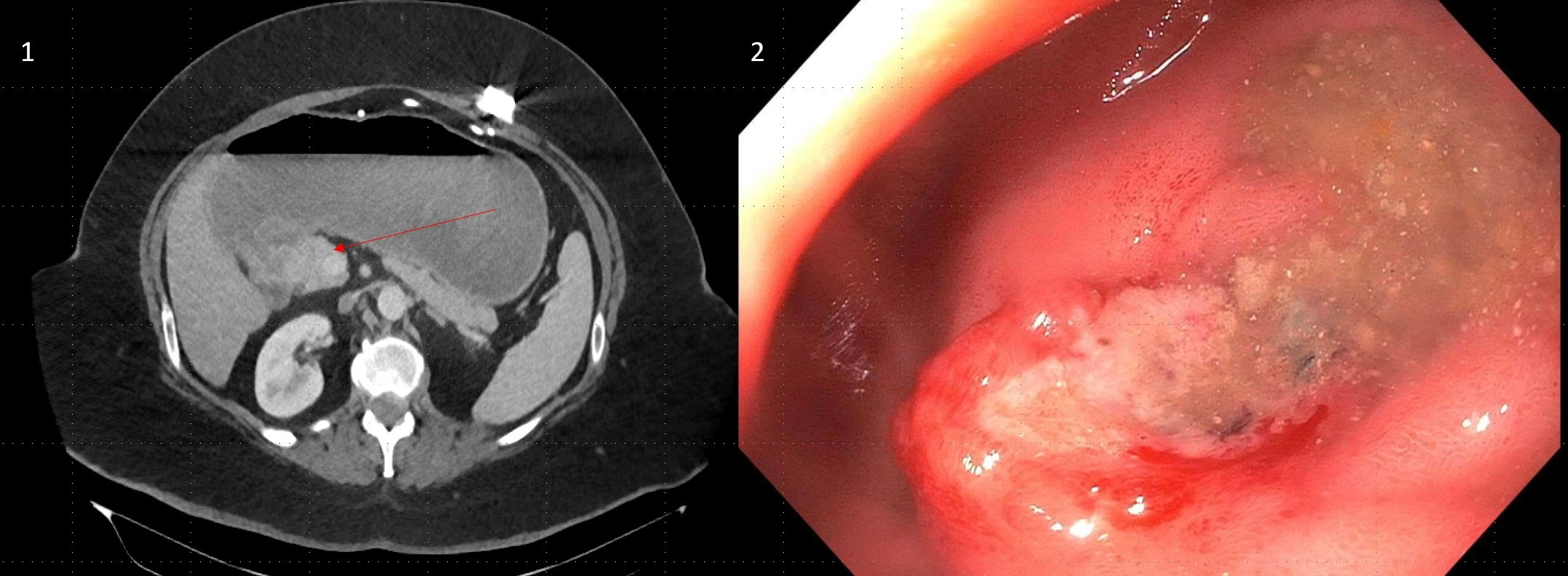Back
Poster Session E - Tuesday Afternoon
E0654 - You Shall Not Pass: Rare Duodenal Bulb Adenocarcinoma Causing Gastric Outlet Obstruction
Tuesday, October 25, 2022
3:00 PM – 5:00 PM ET
Location: Crown Ballroom

Randy Leibowitz, DO
Mount Sinai St. Luke's and Mount Sinai Roosevelt
New York, NY
Presenting Author(s)
Randy Leibowitz, DO1, Alexander Maraveyas, MBChB2, Frederick Rozenshteyn, MD2, Tina Park, MD3
1Mount Sinai St. Luke's and Mount Sinai Roosevelt, New York, NY; 2Icahn School of Medicine at Mount Sinai Morningside-West, New York, NY; 3Mount Sinai Beth Israel, Morningside and West, New York, NY
Introduction: Duodenal carcinoma accounts for only 1-2% of diagnosed gastrointestinal cancers in the United States. Due to its insidious onset, advanced disease is often established at the time of diagnosis resulting in poor outcomes for patients. Although duodenal adenocarcinomas have been found to comprise around half of all small bowel adenocarcinomas, disease arising from within the duodenal bulb in the D1 segment is a vanishingly rare phenomenon.
Case Description/Methods: A 52-year old female with a past medical history of morbid obesity with placement of laparoscopic adjustable gastric band 14 years prior presented with frequent emesis, inability to tolerate oral diet and a 22kg weight loss. Recent esophagogastroduodenoscopy during a previous admission revealed a cratered ulcer in the duodenal bulb. An upper GI series was obtained, showing a 2cm mass in the bulb apex which was confirmed by computed tomography. A repeat esophagogastroduodenoscopy was performed which identified a firm and friable ulcer with contact bleeding with complete obstruction of the duodenal bulb. Subsequent histopathology confirmed the presence of invasive, moderately differentiated adenocarcinoma.
Discussion: Small bowel tumors comprise about 2% of all GI tumors. Adenocarcinoma accounts for about 30% of all small bowel tumors. The duodenum comprises 53% of all small bowel neoplasms. Of duodenal tumors, about 57% occur in the D2 segment of the duodenum. One 2014 meta-analysis of small bowel cancers between 1990-2012 from an institutional registry (excluding ampullary cancers arising from the bile duct mucosa) identified only 30 cases of primary duodenal adenocarcinoma with none arising from D1. A previous 1991 literature review cites 47 cases of primary duodenal adenocarcinoma arising from D1, however, anatomic distinction between the duodenal bulb and the distal D1 segments was not made. Although small bowel tumors are the third leading cause of gastric outlet obstruction, lesions are typically asymptomatic. In a study of 217 primary duodenal adenocarcinoma, the median survival was 20 months with 35% presenting with metastatic disease (39% present with stage III disease).
Although it is difficult to distinguish the prevalence of duodenal bulb neoplasms, it has been clearly demonstrated that neoplasms arising from the D1 segment of the duodenum are extremely rare. By presenting this case, we hope to increase the index of suspicion for small bowel neoplasms as part of the differential for gastric outlet obstruction.

Disclosures:
Randy Leibowitz, DO1, Alexander Maraveyas, MBChB2, Frederick Rozenshteyn, MD2, Tina Park, MD3. E0654 - You Shall Not Pass: Rare Duodenal Bulb Adenocarcinoma Causing Gastric Outlet Obstruction, ACG 2022 Annual Scientific Meeting Abstracts. Charlotte, NC: American College of Gastroenterology.
1Mount Sinai St. Luke's and Mount Sinai Roosevelt, New York, NY; 2Icahn School of Medicine at Mount Sinai Morningside-West, New York, NY; 3Mount Sinai Beth Israel, Morningside and West, New York, NY
Introduction: Duodenal carcinoma accounts for only 1-2% of diagnosed gastrointestinal cancers in the United States. Due to its insidious onset, advanced disease is often established at the time of diagnosis resulting in poor outcomes for patients. Although duodenal adenocarcinomas have been found to comprise around half of all small bowel adenocarcinomas, disease arising from within the duodenal bulb in the D1 segment is a vanishingly rare phenomenon.
Case Description/Methods: A 52-year old female with a past medical history of morbid obesity with placement of laparoscopic adjustable gastric band 14 years prior presented with frequent emesis, inability to tolerate oral diet and a 22kg weight loss. Recent esophagogastroduodenoscopy during a previous admission revealed a cratered ulcer in the duodenal bulb. An upper GI series was obtained, showing a 2cm mass in the bulb apex which was confirmed by computed tomography. A repeat esophagogastroduodenoscopy was performed which identified a firm and friable ulcer with contact bleeding with complete obstruction of the duodenal bulb. Subsequent histopathology confirmed the presence of invasive, moderately differentiated adenocarcinoma.
Discussion: Small bowel tumors comprise about 2% of all GI tumors. Adenocarcinoma accounts for about 30% of all small bowel tumors. The duodenum comprises 53% of all small bowel neoplasms. Of duodenal tumors, about 57% occur in the D2 segment of the duodenum. One 2014 meta-analysis of small bowel cancers between 1990-2012 from an institutional registry (excluding ampullary cancers arising from the bile duct mucosa) identified only 30 cases of primary duodenal adenocarcinoma with none arising from D1. A previous 1991 literature review cites 47 cases of primary duodenal adenocarcinoma arising from D1, however, anatomic distinction between the duodenal bulb and the distal D1 segments was not made. Although small bowel tumors are the third leading cause of gastric outlet obstruction, lesions are typically asymptomatic. In a study of 217 primary duodenal adenocarcinoma, the median survival was 20 months with 35% presenting with metastatic disease (39% present with stage III disease).
Although it is difficult to distinguish the prevalence of duodenal bulb neoplasms, it has been clearly demonstrated that neoplasms arising from the D1 segment of the duodenum are extremely rare. By presenting this case, we hope to increase the index of suspicion for small bowel neoplasms as part of the differential for gastric outlet obstruction.

Figure: Figure 1: CT demonstration of duodenal bulb mass causing gastric outlet obstruction; Figure 2: Endoscopic image of duodenal bulb tumor
Disclosures:
Randy Leibowitz indicated no relevant financial relationships.
Alexander Maraveyas indicated no relevant financial relationships.
Frederick Rozenshteyn indicated no relevant financial relationships.
Tina Park indicated no relevant financial relationships.
Randy Leibowitz, DO1, Alexander Maraveyas, MBChB2, Frederick Rozenshteyn, MD2, Tina Park, MD3. E0654 - You Shall Not Pass: Rare Duodenal Bulb Adenocarcinoma Causing Gastric Outlet Obstruction, ACG 2022 Annual Scientific Meeting Abstracts. Charlotte, NC: American College of Gastroenterology.
